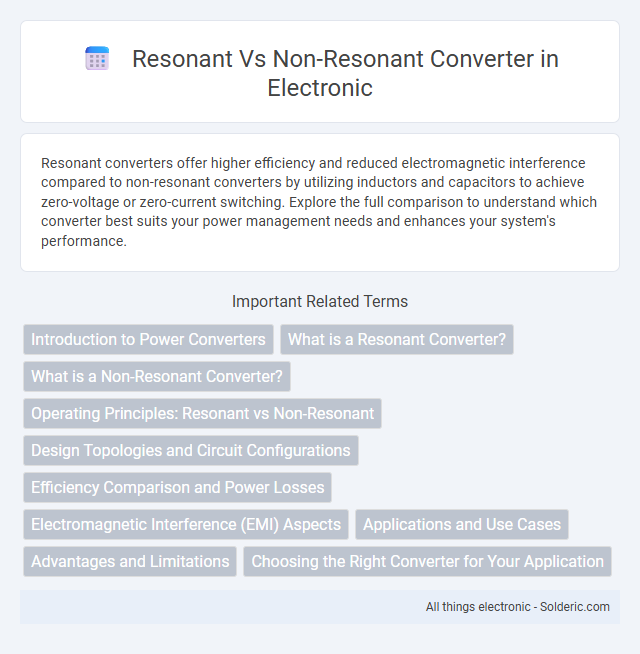Resonant converters offer higher efficiency and reduced electromagnetic interference compared to non-resonant converters by utilizing inductors and capacitors to achieve zero-voltage or zero-current switching. Explore the full comparison to understand which converter best suits your power management needs and enhances your system's performance.
Comparison Table
| Feature | Resonant Converter | Non-Resonant Converter |
|---|---|---|
| Switching Frequency | Operates at resonant frequency for soft switching | Fixed or variable frequency with hard switching |
| Efficiency | Higher efficiency due to reduced switching losses | Lower efficiency, more switching losses |
| Electromagnetic Interference (EMI) | Low EMI due to soft switching | High EMI caused by hard switching |
| Complexity | More complex circuit design and control | Simpler design and control |
| Applications | High-frequency power supplies, RF applications, efficient DC-DC converters | General purpose power supplies, low-cost applications |
| Output Voltage Regulation | More challenging due to dependency on resonant elements | Simple and straightforward regulation |
| Thermal Management | Better thermal performance with reduced losses | Higher heat dissipation required |
Introduction to Power Converters
Power converters transform electrical energy from one form to another, enabling efficient power management in various applications. Resonant converters utilize frequency-tuned components to achieve zero-voltage or zero-current switching, reducing switching losses and electromagnetic interference. Non-resonant converters rely on hard switching techniques, which are simpler but often less efficient and generate higher thermal stress in power devices.
What is a Resonant Converter?
A resonant converter is a type of DC-DC power converter that utilizes a resonant tank circuit composed of inductors and capacitors to achieve zero-voltage switching (ZVS) or zero-current switching (ZCS), minimizing switching losses and electromagnetic interference. This converter operates by transferring energy through the resonance between inductive and capacitive elements, enabling higher efficiency and reduced heat generation compared to traditional non-resonant converters. Resonant converters are widely used in applications requiring high efficiency, such as power supplies for telecommunications, electric vehicles, and LED drivers.
What is a Non-Resonant Converter?
A Non-Resonant Converter is a type of power converter that operates without utilizing resonance between inductive and capacitive components, leading to fixed switching frequencies and higher switching losses. Unlike Resonant Converters, Non-Resonant Converters rely on hard switching techniques, which can cause increased electromagnetic interference and lower efficiency. Understanding your power conversion needs helps determine if a Non-Resonant Converter is suitable, especially for applications requiring simpler control and lower complexity.
Operating Principles: Resonant vs Non-Resonant
Resonant converters operate by utilizing resonance between inductors and capacitors to achieve zero-voltage or zero-current switching, minimizing switching losses and electromagnetic interference. Non-resonant converters rely on hard switching techniques, where semiconductor devices turn on and off abruptly, resulting in higher switching losses and increased thermal stress. The resonant converter's soft-switching mechanism enables higher efficiency and better performance at high frequencies compared to the conventional non-resonant converter.
Design Topologies and Circuit Configurations
Resonant converters utilize LC tank circuits to achieve zero-voltage or zero-current switching, significantly reducing switching losses and electromagnetic interference, with common topologies including Series Resonant Converter (SRC), Parallel Resonant Converter (PRC), and Series-Parallel Resonant Converter (SPRC). Non-resonant converters, such as Buck, Boost, and Flyback converters, rely on traditional hard switching methods without the use of resonant elements, leading to higher switching losses but simpler control and design. Circuit configurations in resonant converters emphasize careful resonance tuning to optimize efficiency and minimize stress, while non-resonant converters focus on straightforward topology to meet cost-effectiveness and ease of implementation.
Efficiency Comparison and Power Losses
Resonant converters achieve higher efficiency by minimizing switching losses through soft switching techniques, significantly reducing power dissipation compared to non-resonant converters that rely on hard switching and incur greater conduction losses. The reduced switching stress in resonant converters leads to lower electromagnetic interference and improved thermal performance, enhancing the overall power conversion efficiency in Your applications. Non-resonant converters often suffer from higher power losses due to rapid voltage and current transitions, making resonant designs preferable for energy-sensitive systems.
Electromagnetic Interference (EMI) Aspects
Resonant converters generate lower electromagnetic interference (EMI) due to their soft-switching techniques, which reduce switching losses and voltage spikes compared to non-resonant converters that rely on hard-switching methods. The reduced dv/dt and di/dt in resonant converters minimize high-frequency noise emissions, improving system electromagnetic compatibility (EMC). Non-resonant converters often require extensive EMI filtering and shielding to meet regulatory standards, increasing system complexity and cost.
Applications and Use Cases
Resonant converters excel in applications requiring high efficiency and low electromagnetic interference, such as in telecommunications power supplies, LED drivers, and wireless power transfer systems. Non-resonant converters are ideal for cost-sensitive applications with variable loads like battery chargers, motor drives, and DC-DC power supplies in consumer electronics. The choice between resonant and non-resonant topologies depends on factors like switching frequency, efficiency targets, and thermal management in industrial automation and aerospace power systems.
Advantages and Limitations
Resonant converters offer high efficiency and reduced electromagnetic interference by operating at resonant frequency, which minimizes switching losses and stress on components. Non-resonant converters provide simpler design and better control at cost of increased switching losses and higher electromagnetic noise. Understanding your power conversion needs helps optimize whether the improved efficiency of resonant types or the straightforward design of non-resonant converters is more suitable.
Choosing the Right Converter for Your Application
Choosing the right converter for your application depends on efficiency, switching frequency, and electromagnetic interference (EMI) requirements. Resonant converters offer higher efficiency and reduced EMI at high frequencies, ideal for applications demanding low noise and precise power delivery. Non-resonant converters provide simplicity, lower cost, and better performance at lower switching frequencies, making them suitable for general-purpose power conversion tasks.
Resonant vs Non-Resonant Converter Infographic

 solderic.com
solderic.com